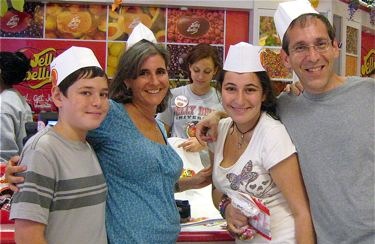 A couple of weeks ago, I posted a video from Aviv’s bar mitzvah along with links to more content on his “bar mitzvah blog.” But before the bar mitzvah itself, I asked to lead the kavanot in honor of Aviv at the Nava Tehila havurah that we participate in once a month. Nava Tehila uses these kavanot as “framing” messages that put the songs of Kabbalat Shabbat in context.
A couple of weeks ago, I posted a video from Aviv’s bar mitzvah along with links to more content on his “bar mitzvah blog.” But before the bar mitzvah itself, I asked to lead the kavanot in honor of Aviv at the Nava Tehila havurah that we participate in once a month. Nava Tehila uses these kavanot as “framing” messages that put the songs of Kabbalat Shabbat in context.
For my kavanot, I tried to tie together the tehilim of Kabbalat Shabbat with some of the themes of Purim, a few general ideas of how I personally relate to these tehilim, while keeping in mind the idea of bar mitzvah and the process of “becoming a man.†If you’re interested in a more “spiritual” post than usual, here’s what I said.
First mizmor לכו × ×¨× × ×”
‎××¨×‘×¢×™× ×©× ×”
Theme: Wandering and searching
This first mizmor doesn’t actually connect with Purim, but I love it anyway, because it speaks to that universal characteristic we all share of “wandering and searching.†In this song is the verse ××¨×‘×¢×™× ×©× ×”. Who hasn’t found themselves at times trying to figure out what they want to do in life, what their best path is, how they should relate to others, what it means to be in a community. That wandering, that contemplation and resolution – even if it’s only partial – makes us stronger, healthier and more grounded.
This mizmor speaks about the story of the Israelites’ 40 years of wandering in the desert – ××¨×‘×¢×™× ×©× ×”- where they found themselves in an entirely new environment, searching for who they wanted to be and what their relationship would, and should, be with God.
Yoel’s song at Nava Tehila focuses on these words:
‎××¨×‘×¢×™× ×©× ×” ×קוט בדור ו×מר ×¢× ×ª×¢×™ לבב ×”× ×œ× ×™×“×¢×• דרכי – “For forty years I strove with that generation. I said ‘They are a people whose hearts go astray, who have not understood my ways.’â€
Eventually, that generation in the desert does find its way – or at least its children do – and they are permitted to move on. They do it through community. They are not individuals but a group forging a common identity.
But there’s also something personal about this concept – it reminds me of transitions of all kinds – the most obvious right now, Aviv’s bar mitzvah, moving from one state to another, as a teenager whose heart may indeed go astray, who is naturally rebellious, and whose mind may not have understood the ways – of his parents, at least!
But ultimately, as teenagers reach adulthood, they do understand, and they own up to their own destiny, like the Israelites did, and inherit the land.
So as we sing the first mizmor, let’s keep in mind wandering, searching and the healing power of transitions.
Second mizmor שירו ליהוה שיר חדש
‎ישמחו ×”×©×ž×™× ×•×ª×’×œ ×”×רץ
Theme: Joy
“Let the heavens rejoice and the earth be glad.†ישמחו ×”×©×ž×™× ×•×ª×’×œ ×”×רץ What a wonderful theme for Purim as in the Purim story we are clearly happy – well, at least about how things turned out – and the Megillah reading is quite joyous. For Purim, and for all of the month of Adar, we sing ושמחתה וחגיך .
But the Purim story also has its dark side. We were almost annihilated. And the Jews in turn fought back and killed enemies and most likely innocents as well. How can we be so joyous? When I discussed this with Rachel, she told me about what it was like at the end of the first Gulf War. I wasn’t here, but Rachel said that everyone poured into the streets, filled with joy and relief. That universal rejoicing after a near catastrophe, it seems, is common to us as human beings, at all times in history.
Unfortunately, we are far from safe today and there is much work that needs to be done. But for now at least, let us embrace a moment of joy, in honor of Purim and for ourselves as well.
Third mizmor יהוה מלך תגל ×”×רץ
‎×ור זרוע לצדיק
Theme: Corruption/Leadership
This mizmor speaks to me about the nature of leadership, and its unfortunate companion, corruption. There is the line ×ור זרוע לצדיק ולישרי לב שמחה which can be translated as “Light is sown for the righteous and joy for the upright in heart.†What do we mean by “sowing light†here? For whom are we supposed to be sowing this light? Who needs it the most?
I would say, both in the Purim story and today, it is our wish to bring light to our leaders. To hold those who may be less than straight, accountable, and to teach our own children how to be moral and ethical representatives.
How does Ahashverous treat women in the Purim story? Well, Vashti is killed and the search for a new queen – through what’s essentially American Idol with sex – doesn’t exactly win points in a modern context. Mordechai doesn’t come off so well either. Sure, things worked out OK in the end, but urging his niece to join a harem isn’t what I’d wish for my daughter.
We need smart, decent and upright leaders who exude the light of doing what is right. Who don’t expropriate land that is not theirs because they’re high ranking army officers, who do not take bribes to build 40 story buildings, who don’t abuse their office with the women who work there. It starts right now. In this room. With our children. With our family. With our community’s leaders. This is what I think about when we sing the next mizmor.
Fourth mizmor מזמור שירו ליהוה
â€Ž×™×¨×¢× ×”×™× ×•×ž×œ×•×ו
Theme: Nafochu
One of the most interesting themes of Purim is that of × ×”×¤×•×š ×”×•× â€“ where everything flips – bad becomes good. They were going to kill us, we survived, let’s have a party. But it’s more than that. When everything flips, we’re thrown out of balance, out of our comfort zone. We’re not sure which way to go, the room starts to spin. In all this craziness, though, there is the opportunity for us to make change, in ourselves and in the world.
The bar mitzvah boy is certainly thrown into a spin as he hits the teen years. Who is he, what kind of friends does he choose, what are his passions? It can be challenging, but there is also something wonderful in the process.
Coming back to Purim, is it possible to go from survival mode – the Jewish people after beating back its enemies in Shushan – to a more global perspective, where we finally become a light unto the nations? How about today?
So why am I bringing up this idea of × ×”×¤×•×š ×”×•× for this particular mizmor? Normally in prayer, the concept centers around looking at the wonders of nature and, as a result, wanting to sing and praise God. But the words here suggest the opposite – ×™×¨×¢× ×”×™× ×•×ž×œ×•××•â€¦× ×”×¨×•×ª ימח×ו ×›×£ יחד ×”×¨×™× ×™×¨× × ×• – It says that sea is thundering and the rivers are clapping hands and the mountains are singing - It is nature itself here that, according to the verse, sings praise to God here. × ×”×¤×•×š ×”×•× indeed!
Fifth mizmor יהוה מלך ירגזו עמי×
No kavana
Sixth mizmor מזמור לדוד
No kavana
Lecha Dodi לכה דודי
Theme: Hiddenness
Before we sing Lecha Dodi, I want to talk briefly about perhaps the most debated themes of the Megillah: the hiddenness of God. While there has been much written about what God’s hiding means, about the meaning of the name Esther, I want to ask from a more psychological perspective.
What else is hidden in our lives? Do we hide our feelings? Do we hide who we are and what we would like to be as we grow up (and as we grow old)? Do we keep secrets from others, from ourselves? Do we find ourselves trying to fit into a box that we believe that people want us to fit into, or are we ultimately true to ourselves, hiding nothing?
That’s certainly a theme that a bar mitzvah boy on the cusp of becoming a teenager can relate to, but it’s something we all can. How do we relate to tradition, to commandments and mitzvot, to school, to work, to community in a way that is true to ourselves and true to the Jewish people?
Lecha Dodi is actually the antidote to all this hiddenness. It is only when we finally embrace what we know to be true can we walk forward in confidence to welcome the Sabbath Bride. In the words of Lecha Dodi itself, we are going out to greet “the face†לכה דודי לקר×ת כלה ×¤× ×™ שבת × ×§×‘×œ×”. One on one. Nothing hidden anymore. It is the most important relationship of them all, and behind all its mystical symbolism, there is the message of love. It may sound a bit corny – especially in a room full of therapists – but in order to love your beloved, you must first love yourself.
Can you do that? Let’s sing…
Final mizmor מיזמור שיר ×œ×™×•× ×”×©×‘×ª
‎טוב להודות
Theme: Gratitude
I couldn’t let us end the evening without taking a moment to give thanks. And what better mizmor than the one that includes טוב להודות. It is healthy to say thank you. When we’re grateful, we go beyond ourselves. We have energy for the other. That’s why many people keep a nightly gratitude journal.
Tonight I want to say thank you to our family for coming all the way to Israel, to this community for allowing me to share these words tonight, to our success in the Purim story that we could survive another day, to Israel for strengthening our ability to sustain ourselves with independence and pride, and of course to Aviv, whose big day has brought so many of us together.

